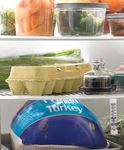Egg Safety: What You Need to Know - FDA
←
→
Page content transcription
If your browser does not render page correctly, please read the page content below
Egg Safety: What You Need to Know
Fresh eggs, even those with clean, uncracked shells, may contain
bacteria called Salmonella that can cause foodborne illness, often
called “food poisoning.” FDA has put regulations in place to help
prevent contamination of eggs on the farm and during shipping
and storage, but consumers also play a key role in preventing
illness linked to eggs. Protect yourself and your family by following
these safe handling tips when buying, storing, preparing, and
serving eggs or foods that contain them.
What is Salmonella?
Salmonella, the name of a group of bacteria, is a common cause
of food poisoning in the United States. Most people infected
with Salmonella develop diarrhea, fever, abdominal cramps, and
vomiting 12 to 72 hours after infection. Symptoms usually last 4 to
7 days and most people get better without treatment. However,
in some people, the diarrhea may be so severe that they need to
be hospitalized. In these patients, the Salmonella infection may
spread from the intestines to the blood stream, and then to other
body sites and can cause death unless the person is treated
quickly with antibiotics. Certain people are at greater risk for
severe illness and include children, older adults, pregnant women,
and people with weakened immune systems (such as transplant
patients and individuals with HIV/AIDS, cancer, and diabetes).
Protect yourself and your family
by following these safe handling FDA requires all cartons of shell eggs that have not been treated to
tips when buying, storing, destroy Salmonella to carry the following safe handling statement:
preparing, and serving eggs
or foods that contain them. SAFE HANDLING INSTRUCTIONS
To prevent illness from bacteria:
keep eggs refrigerated, cook eggs
until yolks are firm, and cook foods
containing eggs thoroughly.
Eggs that have been treated to destroy
Salmonella—by in-shell pasteurization,
for example—are not required to carry
safe handling instructions, but the
labeling will usually say that they have
been treated.
March 2021 1Buying
You can help keep eggs safe by making wise buying decisions at the
grocery store.
• Buy eggs only if sold from a refrigerator or refrigerated case.
• Open the carton and make sure that the eggs are clean and the shells are not
cracked.
• Store promptly in a clean refrigerator at a temperature of 40° F or below.
Use a refrigerator thermometer to check.
• Store eggs in their original carton and use them within 3 weeks for best quality.
Storing
Proper storage of eggs can affect both quality and safety.
• Use hard-cooked eggs (in the shell or peeled) within 1 week after cooking.
• Use frozen eggs within 1 year. Eggs should not be frozen in their shells. To
freeze whole eggs, beat yolks and whites together. Egg whites can also be
frozen by themselves.
• Refrigerate leftover cooked egg dishes and use within 3 to 4 days. When
refrigerating a large amount of a hot egg-containing leftover, divide it into
several shallow containers so it will cool quickly.
Preparing
Wash hands, utensils, equipment, and work surfaces with hot, soapy
water before and after they come in contact with raw eggs and raw
egg-containing foods.
• Cook eggs until both the yolk and the white are firm. Scrambled eggs should
not be runny.
• Casseroles and other dishes containing eggs should be cooked to 160° F.
Use a food thermometer to be sure.
• For recipes that call for eggs that are raw or undercooked when the dish is
served, like Caesar salad dressing and homemade ice cream:
– Use either shell eggs that have been treated to destroy Salmonella, by
pasteurization or another approved method, or pasteurized egg products.
March 2021 2Serving
Follow these serving guidelines for eggs and egg dishes.
• Serve cooked eggs (such as hard-boiled eggs and fried eggs) and egg-
containing foods (such as such as quiches and soufflés) immediately after
cooking. Cooked eggs and egg dishes may be refrigerated for serving later but
should be thoroughly reheated to 165° F before serving.
• Never leave cooked eggs or egg dishes out of the refrigerator for more than
2 hours or for more than 1 hour when temperatures are above 90° F. Bacteria
that can cause illness grow quickly at warm temperatures (between 40° F and
140° F).
• For party planning, keep hot egg dishes hot and cold egg dishes cold:
– Keep egg dishes refrigerated until time to serve.
– Serve small platters of reheated egg dishes at a time to ensure the food stays
at the proper temperature. Replenish as needed, or at least every 2 hours.
– Keep cold egg dishes on ice if they are going to stay out longer than 2 hours.
Transporting
• For picnics, pack cooked eggs and egg dishes in an insulated cooler with
enough ice or frozen gel packs to keep them cold. Transport the cooler in the
passenger compartment of the car, not in the much warmer trunk. At the picnic
area, put the cooler in the shade if possible and keep the lid closed as much as
you can.
• For school or work, pack cooked eggs with a small frozen gel pack or a frozen
juice box.
About Foodborne Illness
Know the Symptoms
Consuming dangerous foodborne bacteria will usually cause illness within 1 to 3 days of
eating the contaminated food. However, sickness can also occur within 20 minutes or
up to 6 weeks later. Although most people will recover from a foodborne illness within a
short period of time, some can develop chronic, severe, or even life-threatening health
problems. Foodborne illness can sometimes be confused with other illnesses that have
similar symptoms. The symptoms of foodborne illness can include:
• Vomiting, diarrhea, and abdominal pain
• Flu-like symptoms, such as fever, headache, and body ache
Take Action
If you think that you or a family member has a foodborne illness, contact your
healthcare provider immediately. Also, report the suspected foodborne illness to FDA
in either of these ways:
• Contact the Consumer Complaint Coordinator in your area. Locate a coordinator here:
http://www.fda.gov/Safety/ReportaProblem/ConsumerComplaintCoordinators
• Contact MedWatch, FDA’s Safety Information and Adverse Event Reporting Program:
By Phone: 1-800-FDA-1088
Online: File a voluntary report at http://www.fda.gov/medwatch
March 2021 3Safe Food Handling: Four Simple Steps
CLEAN SEPARATE
Wash hands and surfaces often Separate raw meats from other foods
Wash your hands with warm water and soap for at least Separate raw meat, poultry, seafood, and
20 seconds before and after handling food and after eggs from other foods in your grocery
using the bathroom, changing diapers, and handling pets. shopping cart, grocery bags, and refrigerator.
Wash your cutting boards, dishes, utensils, and counter Use one cutting board for fresh produce
tops with hot soapy water after preparing each food item. and a separate one for raw meat, poultry,
and seafood.
Consider using paper towels to clean up kitchen
surfaces. If you use cloth towels, launder them often in Never place cooked food on a plate that
the hot cycle. previously held raw meat, poultry, seafood,
or eggs unless the plate has been washed in
Rinse fresh fruits and vegetables under running tap
hot, soapy water.
water, including those with skins and rinds that are not
eaten. Scrub firm produce with a clean produce brush. Don’t reuse marinades used on raw foods
unless you bring them to a boil first.
With canned goods, remember to clean lids before
opening.
CHILL
Refrigerate foods promptly
COOK
Cook to the right temperature Use an appliance thermometer to be sure the
temperature is consistently 40° F or below and
Color and texture are unreliable indicators of safety.
the freezer temperature is 0° F or below.
Using a food thermometer is the only way to ensure the
safety of meat, poultry, seafood, and egg products for Refrigerate or freeze meat, poultry, eggs, seafood,
all cooking methods. These foods must be cooked to and other perishables within 2 hours of cooking
a safe minimum internal temperature to destroy any or purchasing. Refrigerate within 1 hour if the
harmful bacteria. temperature outside is above 90° F.
Cook eggs until the yolk and white are firm. Only use Never thaw food at room temperature, such as
recipes in which eggs are cooked or heated thoroughly. on the counter top. There are three safe ways to
When cooking in a microwave oven, cover food, stir, defrost food: in the refrigerator, in cold water, and
and rotate for even cooking. If there is no turntable, in the microwave. Food thawed in cold water or in
rotate the dish by hand once or twice during cooking. the microwave should be cooked immediately.
Always allow standing time, which completes the Always marinate food in the refrigerator.
cooking, before checking the internal temperature with
Divide large amounts of leftovers into shallow
a food thermometer.
containers for quicker cooling in the refrigerator.
Bring sauces, soups and gravy to a boil when reheating.
March 2021 4
For more information, contact the U.S. Food and Drug Administration, Center for Food Safety and Applied Nutrition’s Food and
Cosmetic Information Center at 1-888-SAFEFOOD (toll free), Monday through Friday 10 AM to 4 PM ET (except Thursdays from
12:30 PM to 1:30 PM ET and Federal holidays). Or, visit the FDA website at http://www.fda.gov/educationresourcelibraryYou can also read

























































